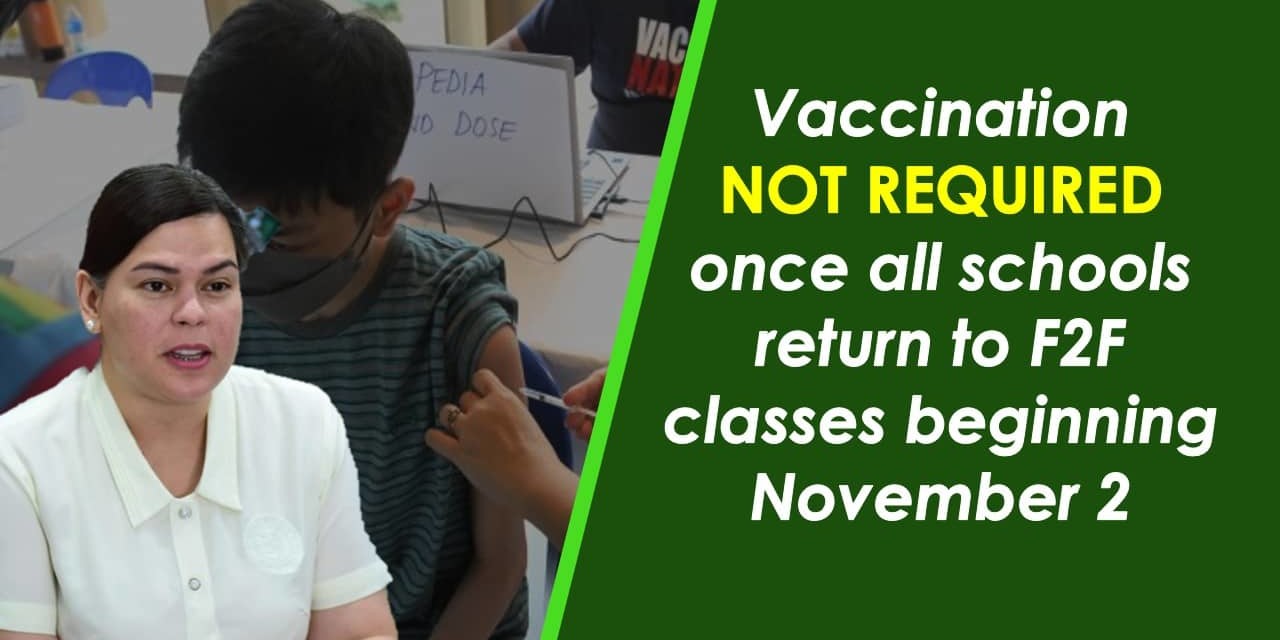Vice President and Education Secretary Sara Duterte said, ”There should be no segregation, no discrimination for the unvaccinated learners because vaccination is not mandatory.”
Vice President Sara Duterte’s first directive as concurrent secretary for education was a strident directive for all schools across the nation to resume face-to-face instruction on November 2.
The students’ return to the conventional method of instruction did not come with any prerequisites. They are not required to receive the deadly virus vaccination that has so far killed 60,000 people and infected over 3.7 million in the Philippines.
“There should be no segregation, no discrimination for the unvaccinated learners because vaccination is not mandatory and we don’t see any problem with co-mingling of students inside classroom. Because when outside, in their respective houses, in malls, in churches, and in public transportation, students are co-mingling whether vaccinated or not,” in an ambush conversation with reporters on Thursday, July 14, Duterte spoke in a mix of English and Filipino.
Even though the Philippines’ 110 million people were fully immunized against COVID-19, just 9.6 million adolescents and 3.7 million children were. This is despite the fact that vaccination coverage in the country reached over 60%. The most recent school year, 2021–2022, has about 28 million children enrolled in basic education.
There was no obligation for vaccinations, and there was no cap on the number of students each class. Physical segregation will be used, according to Duterte, “whenever possible.”
“Hindi po kami naglagay ng exact size ng class dahil iba-iba po ‘yung situation ng lahat ng mga schools natin. There are no schools na pare-pareho sila exactly sa kanilang classrooms and sa kanilang teacher,” she stated.
Lack of classrooms was an issue even before the outbreak. One classroom, apparently designed for a class of 40, was crammed with 50 to 60 pupils. Class shuffling had been put in place to make up for the lack of classroom space and handle the yearly increase in enrollment.
Duterte stated that the government would build extra classrooms to accommodate overcrowded classes, even though physical distance won’t be enforced. When asked how many classrooms they planned to construct, Duterte responded that her office will look into the matter and later give the information to the public.
Accoding to the Vice-President, “Overpopulation naman is a matter of classroom construction. There is a backlog of classroom construction and gumagawa kami ngayon ng department order na, magstre-streamline ng requests ng construction ng classroom para naiiwasan natin ‘yung paglalagay ng projects na unimplementable (we’re drafting a department order that would streamline requests for classroom construction so we could prevent unimplementable projects),”
Students who are deemed to be “unwell” or who have been issued a COVID-19 diagnosis are exempt from attending in-person classes. Duterte added, “The learner can perform blended style of delivery if the learner feels poorly.”
In-person instruction should resume, according to Duterte, as COVID-19 vaccines are now widely available. The government started immunizing children between the ages of 5 and 11 in February.
“Since public health professionals previously stated that a vaccination was required, we are not waiting for anything in regards to this pandemic, so wala na po tayong hihintayin (we are not waiting for anything).” The shot is already in place. They stated, “We need the medication,” in their words. The medication has already arrived, she continued.
The Philippines is one of the few nations in the world whose schools have not fully opened for in-person instruction more than two years into the outbreak. There were around 25,786 schools offering in-person classes as of April 22.
In the nation, there are thought to be 60,000 public and private schools.
Studies have shown that the distant learning system results in pupils “learning less.” The learning deficits caused by the epidemic disturbed experts and legislators.
According to World Bank data, the number of learning-adjusted years of school (LAYS) in the Philippines will be reduced from 7.5 years before to the pandemic to 5.9 to 6.5 years, depending on how long additional school closures last and how well the remote learning system works.
This indicates that although the basic education system in the Philippines gives 12 years of training, Filipino students demonstrate proficiency after only about six years of formal schooling.

